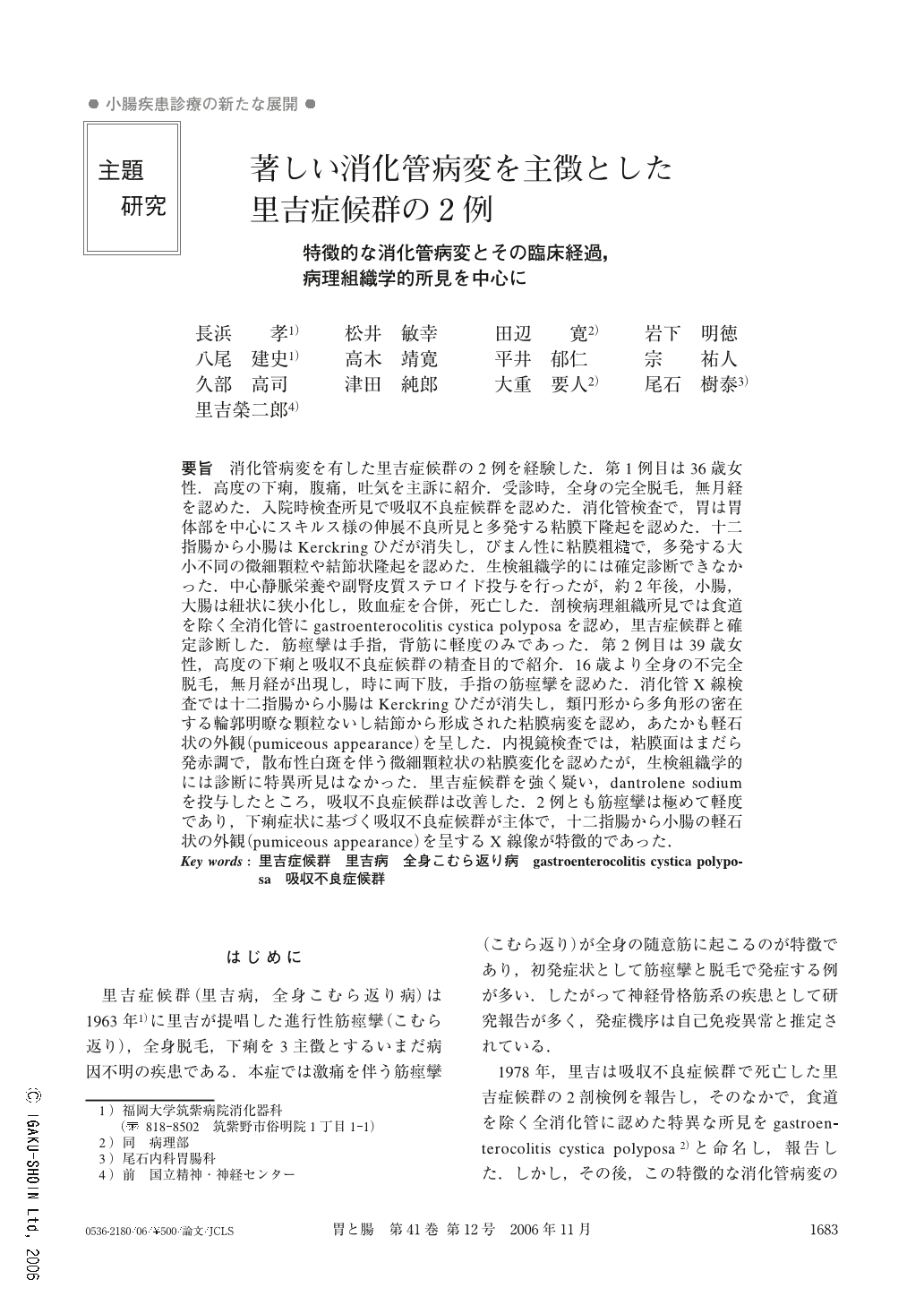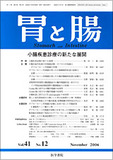Japanese
English
- 有料閲覧
- Abstract 文献概要
- 1ページ目 Look Inside
- 参考文献 Reference
- サイト内被引用 Cited by
要旨 消化管病変を有した里吉症候群の2例を経験した.第1例目は36歳女性.高度の下痢,腹痛,吐気を主訴に紹介.受診時,全身の完全脱毛,無月経を認めた.入院時検査所見で吸収不良症候群を認めた.消化管検査で,胃は胃体部を中心にスキルス様の伸展不良所見と多発する粘膜下隆起を認めた.十二指腸から小腸はKerckringひだが消失し,びまん性に粘膜粗ぞうで,多発する大小不同の微細顆粒や結節状隆起を認めた.生検組織学的には確定診断できなかった.中心静脈栄養や副腎皮質ステロイド投与を行ったが,約2年後,小腸,大腸は紐状に狭小化し,敗血症を合併,死亡した.剖検病理組織所見では食道を除く全消化管にgastroenterocolitis cystica polyposaを認め,里吉症候群と確定診断した.筋痙攣は手指,背筋に軽度のみであった.第2例目は39歳女性,高度の下痢と吸収不良症候群の精査目的で紹介.16歳より全身の不完全脱毛,無月経が出現し,時に両下肢,手指の筋痙攣を認めた.消化管X線検査では十二指腸から小腸はKerckringひだが消失し,類円形から多角形の密在する輪郭明瞭な顆粒ないし結節から形成された粘膜病変を認め,あたかも軽石状の外観(pumiceous appearance)を呈した.内視鏡検査では,粘膜面はまだら発赤調で,散布性白斑を伴う微細顆粒状の粘膜変化を認めたが,生検組織学的には診断に特異所見はなかった.里吉症候群を強く疑い,dantrolene sodiumを投与したところ,吸収不良症候群は改善した.2例とも筋痙攣は極めて軽度であり,下痢症状に基づく吸収不良症候群が主体で,十二指腸から小腸の軽石状の外観(pumiceous appearance)を呈するX線像が特徴的であった.
We encountered 2 cases of Satoyoshi syndrome with gastrointestinal lesions. The first was a 36-year-old female patient who was referred to our hospital with the chief complaints of severe diarrhea, abdominal pain and nausea. She had universal alopecia and amenorrhea at the time of the initial examination. Examination findings on admission revealed evidence of malabsorption syndrome. Gastrointestinal examination revealed scirrhus-like findings, with poor distention and multiple submucosal protrusions in the stomach including the body and elimination of Kerckring folds, diffusely roughened mucosa, and multiple nodular protrusions extending from the duodenum to the small intestine. Despite obtaining multiple biopsy specimens, no definite histopathological diagnosis could be made. The patient was initiated on parenteral nutrition and treatment with adrenocortical steroid. However, she showed fibrous narrowing of both the small intestine and the large intestine approximately two years later. There was also evidence of sepsis, and the patient died. Histopathological findings on autopsy revealed the presence of gastroenterocolitis cystica polyposa extending across the length of the gastrointestinal tract, excluding the esophagus, and a definitive diagnosis of Satoyoshi syndrome was made. A review of the examination findings at a previous hospital showed that the patient had suffered from spasms of the fingers and of the dorsal muscles. In the subsequent course, muscle spasms had been confirmed only three times.
The second case was a 39-year-old female patient with severe diarrhea and malabsorption syndrome who was referred to our hospital for thorough investigation. She gave a history of universal alopecia and amenorrhea since the age of 16 years, and she occasionally suffered from spasms of the fingers and legs. A radiogram of the gastrointestinal tract revealed, so-called “pumiceous appearance”, that is, elimination of Kerckring folds, diffuse roughening of the mucosa, and multiple nodular protrusions extending from the duodenum to the small intestine. A gastrointestinal endoscopic examination revealed irregular erythematous and fine granular changes in the mucosa with disseminated white spots in the first and second parts of the duodenum. The above-described findings bore close resemblance to the lesions of the duodenum and small intestine described in the first case. The patient was, therefore, strongly suspected to have Satoyoshi syndrome, and was started on treatment with dantrolene sodium, with clinical improvement of malabsorption syndrome.
In both cases, the muscle spasms were extremely mild, and the primary presenting features were diarrhea and the malabsorption syndrome.

Copyright © 2006, Igaku-Shoin Ltd. All rights reserved.


